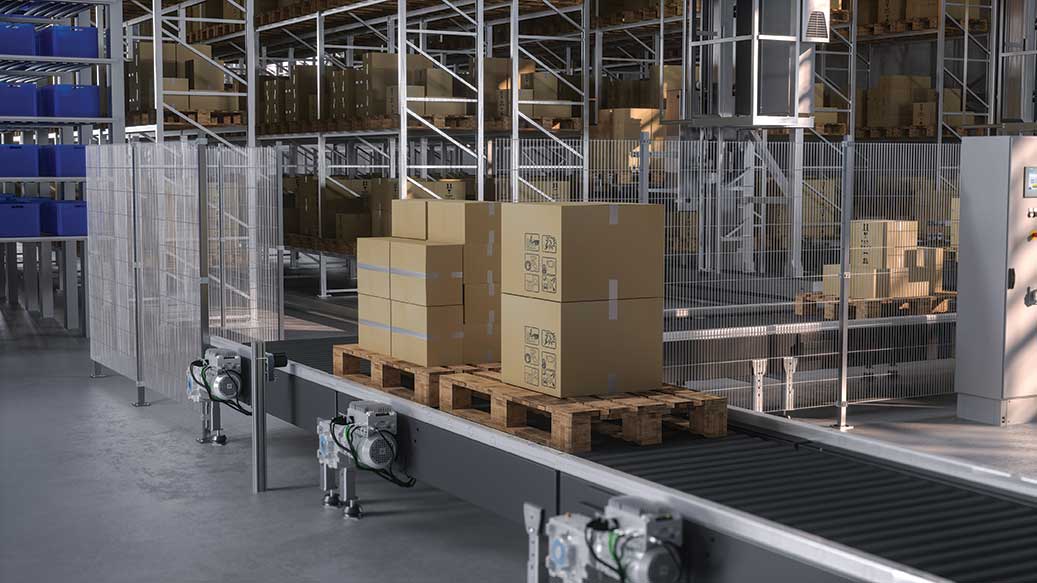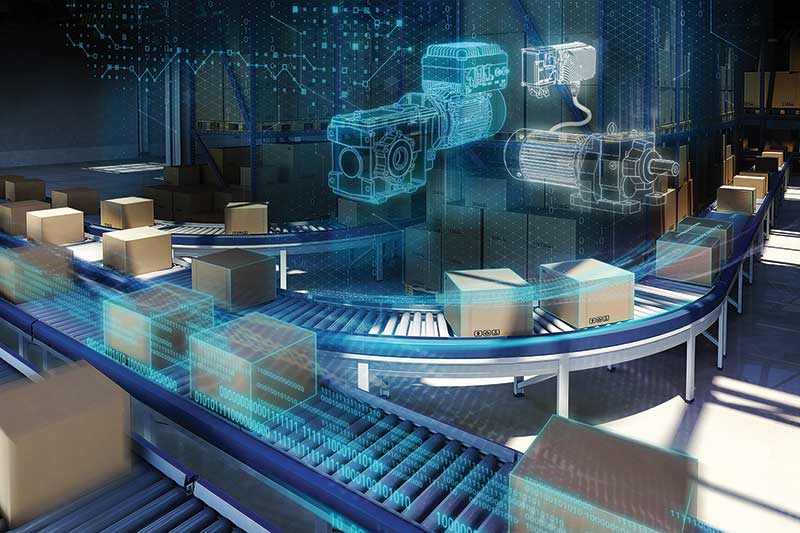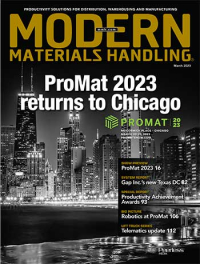A new look for motors, gearboxes and gears
Power transmission equipment is not only starting to look different, but operate differently, too. This is a time when sustainability, decentralization and digitalization are all having a far reaching impact.
“Whatever you were doing five years ago, you need to rethink it all now.”
That’s Craig Henry’s take on power transmission for materials handling equipment. And as Siemens’ U.S. industry manager for intralogistics, Henry is close to the shift in priorities for selecting motors, gearboxes and gears.
In fact, he, and others from NORD, Lenze and Beckhoff, identify the same top drivers of what is being rethought.
The key words here are sustainability, decentralization, digitalization and maintenance. All are strong motivators as companies rethink power transmission.
But first, let’s put it all in perspective. While all of this is significant, it takes forethought and planning to implement an engineered solution with these benefits, says Jordan Mukite, key market specialist for intralogistics at NORD.
This is neither a crisis nor an inflection point. Instead, Mukite says, each of those four key words is receiving considered attention for the potential impact on specific pieces of equipment and how it can contribute to overall process improvement, cost efficiencies and corporate objectives going forward.
“Companies are not approaching this in a revolutionary fashion,” says Henry. “They are looking for local gains first and then determining how that fits into the company’s strategic direction on specific metrics. Each company is approaching this switch out of power transmission equipment as a directed progression that suits the company. What works for Chick-fil-A is different than what adidas needs. But ultimately, all will get to a better spot,” adds Henry.
Sometimes that requires new approaches, says Tim-Oliver Ricke, Lenze’s global segment manager for materials handling and logistics and head of intralogistics engineering. “Our newest warehouse has become our own internal test lab where we currently apply and train our technology. The warehouse is also our showcase to prepare customers for what can be done with new power transmission technology,” says Ricke.
At the same time, a shift is underway in the decision-making process for power transmission equipment, says Doug Schuchart, Beckhoff’s global intralogistics and materials handling manager. “More end users are writing and sharing their own specs with OEMs on the profile of the power transmission technologies they expect in equipment from robots to automated storage systems.”
The power of sustainability
Perhaps what’s most interesting about sustainability is that it has clearly graduated from being a buzzword to being an important metric of operational success.
“Sustainability is essential now. Companies have set internal objectives for sustainability metrics. And power transmission equipment is now being replaced because only new technology can meet the latest energy consumption goals. Monitoring energy consumption more closely has the dual benefit of helping to predict failures in power transmission equipment and wear on the mechanical system around it,” says Beckhoff’s Schuchart.

No one disagrees with him.
The headliner here is energy consumption/efficiency. But where it fits into the ROI calculation depends, says James Chandler, key markets manager at NORD. In other words, this is a little more complicated than reading the energy efficiency of a new refrigerator at your local Lowe’s.
His colleague Mukite says that it’s important to prioritize the materials handling equipment that needs attention first. “You need to look at the overall utilization of electricity then break it down by which power transmission equipment is consuming the most. Another key place to start is to compare the energy consumption of the equipment that generally runs at variable speeds and partial loads.
“For instance, a higher motor rating, IE4 rather than IE3, improves energy efficiencies. But also important is the efficiency of the motor across varied operational speeds and loads. The newest rating, IE5, contributes to this level of performance at various RPMs,” adds Chandler.
Furthermore, IE5 synchronous motors can be brought to zero speed and still be on, but draw almost no power, explains Siemens’ Henry. He says these are all incremental improvements that typically increase energy efficiency either side of 10%.
A demand-oriented design is one of the essential factors when it comes to energy efficiency; however, the application must also be considered in its entirety, says Lenze’s Ricke. Within this process, he says, it’s a must to keep the problem of the cascaded buffers in mind. That means small inefficiencies or small over dimensioning decisions have a significant effect on overall system efficiency. In a simplified example, Ricke says, use of a motor with a nominal efficiency of 90%, and a gearbox with a nominal efficiency of 90% means that the total efficiency will be 81% and not 90%. That’s significant.
Meanwhile, Henry talks about a shift to synchronous reluctance motors from induction motors. The energy efficiency increase here depends on motor size with higher horsepower motors delivering higher efficiencies.
Schuchart talks about a shift in certain specialized conveyor applications from three-phase AC induction motors to higher voltage (24 to 48 V) BLDC powered motors. He says the combination of higher torque and DC power provides notable energy efficiency.
Regardless of the technology used to raise energy efficiency, the bottom line is this: Energy efficiency is now part of the ROI calculation for power transmission equipment and cannot be overlooked going forward.
Interest in decentralization
The traditional, centralized approach to power transmission equipment control is also under scrutiny. The emphasis is no longer on centralized control cabinets that run many pieces of equipment. Instead, the latest approach is to decentralize control all the way down to mounting controls directly on the motor.
Chandler of NORD explains that this modular approach has several advantages. These include on-site control that provides equipment-independent monitoring and ease of access for maintenance techs. And while decentralized, the controllers are easily networked to provide data in a real-time mode.
Ricke of Lenze cites the move away from control cabinets as reducing installation costs and time. In addition, this simplification of the technology means installers and even maintenance techs require fewer skills to install and maintain the equipment, a key consideration given the current labor situation, adds Ricke.
Mukite at NORD jumps right to maintenance here. Modularity generally simplifies and reduces the mass of the equipment, he says. It also makes it easier for techs to swap out components when required. The end result is power transmission equipment that is simpler and easier to maintain.
Also with the move to modularity, options are not lacking to manage data across the centralized network, says Ricke. Networks, field-buses, PC-based controls as well as programmable logic controllers and Edge controllers are part of this mix. Schuchart indicates that end users are seeking more flexibility in their operations to rapidly adapt to shifting business requirement and changes in consumer demand. That flexibility is achievable with modular, decentralized systems.
In addition, Schuchart describes analytics platforms that allow real-time monitoring and analysis of operational data coming directly from power transmission equipment.
Moving onto digitalization
All of which moves the decision-making process naturally to the brave new world of digitalization.
Schuchart calls it moving data from the shaft to the Cloud, which about says it all. Digitalization is focused on much more than monitoring and tracking energy efficiency. Digitalization is about asset management, says Ricke.
“Complete digitalization of an operation is a big undertaking that includes end users and suppliers alike as well as technologies with an ability to transmit massive amounts of data while maintaining extremely fast control update rates,” says Schuchart.
The first step is to collect data even if you don’t know exactly what you’ll do with it, he adds. In other words, digitalization is coming at an opportune time, providing end users with new abilities don’t just monitor, but manage the total cost of ownership.
To begin, you have sensors. Power transmission equipment is being outfitted with many to digitally record and share everything from shaft speeds to torque trends and heat buildup. Using software and analysis platforms, the data is first collected and then analyzed to evaluate equipment efficiency, its impact on operational processes and maintenance needs both now and in the future (read, predictive maintenance).
Henry foresees a time when companies will build a digital twin of their operations, much beyond the focus here on power transmission equipment. He says this digital twin will become its own operations center with a software model running alongside the actual hardware in the facility. “The four key steps here will be to simulate operations, emulate them, run alongside the actual system and analyze what to do next,” says Henry.

Bringing this back to power transmission, Lenze’s Ricke says the terms condition monitoring and predictive maintenance are often misused and misunderstood.
“At Lenze, we are working on ‘real’ prediction to detect bearing failures, broken teeth in a gearbox, and misalignment of components in conveying systems before actual break downs occur,” explains Ricke. “We then use artificial intelligence and machine learning algorithms on premise and in the Cloud.”
Get it right
All of which is quite a distance from where power transmission was five years ago. Those were the days when you and your colleagues had little interest and often even less knowledge about the motors and such that came with OEM materials handling equipment.
That paradigm is clearly shifting. Not only are end users getting more involved here, but the solutions are becoming increasingly specific to companies and their goals.
As Henry points out, UPS, DHL, USPS and FedEx may all be in the same business, but they each have their own approach to the power transmission equipment suited to their operations. Fortunately, that is now not just possible, but highly manageable.
Or as Henry says: “The technology of power transmission is changing so quickly right now, it will astonish us all. We are at the point of a true technology renaissance.”

Article Topics
Lenze Americas News & Resources
A new look for motors, gearboxes and gears Lenze Americas announces new president and CEO A fresh look at power transmission Lenze expands its i500 frequency inverter range Build smart machines with Lenze’s motion-centric automation solutions Lenze Americas hosts STEM career day for local students Lenze introduces motor package tailored for materials handling tasks More Lenze AmericasLatest in Materials Handling
Registration open for Pack Expo International 2024 Walmart chooses Swisslog AS/RS and software for third milk processing facility NetLogistik partners with Vuzix subsidiary Moviynt to offer mobility solutions for warehouses Materials Handling Robotics: The new world of heterogeneous robotic integration BSLBATT is looking for new distributors and resellers worldwide Lucas Watson appointed CSO for Körber’s Parcel Logistics business in North America Hyster recognizes Dealers of Distinction for 2023 More Materials HandlingAbout the Author
Subscribe to Materials Handling Magazine

Find out what the world's most innovative companies are doing to improve productivity in their plants and distribution centers.
Start your FREE subscription today.
April 2024 Modern Materials Handling

Latest Resources












